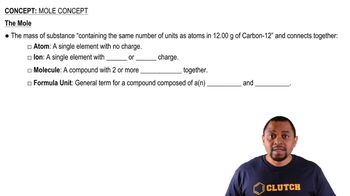Calculate the empirical formula for each natural flavor based on its elemental mass percent composition. a. methyl butyrate (component of apple taste and smell): C 58.80%, H 9.87%, O 31.33%
Ch.3 - Molecules and Compounds

Chapter 3, Problem 92
The elemental mass percent composition of ascorbic acid (vitamin C) is 40.92% C, 4.58% H, and 54.50% O. Determine the empirical formula of ascorbic acid.
 Verified step by step guidance
Verified step by step guidance1
Assume you have 100 grams of ascorbic acid. This allows you to directly convert the percentage of each element to grams: 40.92 g of C, 4.58 g of H, and 54.50 g of O.
Convert the mass of each element to moles by dividing by their respective molar masses: \( \text{Molar mass of C} = 12.01 \, \text{g/mol} \), \( \text{Molar mass of H} = 1.01 \, \text{g/mol} \), \( \text{Molar mass of O} = 16.00 \, \text{g/mol} \).
Calculate the moles of each element: \( \text{moles of C} = \frac{40.92}{12.01} \), \( \text{moles of H} = \frac{4.58}{1.01} \), \( \text{moles of O} = \frac{54.50}{16.00} \).
Determine the simplest whole number ratio of moles of each element by dividing each by the smallest number of moles calculated in the previous step.
If necessary, multiply the ratios by a common factor to obtain whole numbers for each element, which will give you the empirical formula of ascorbic acid.

Verified video answer for a similar problem:
This video solution was recommended by our tutors as helpful for the problem above.
Video duration:
1mWas this helpful?
Key Concepts
Here are the essential concepts you must grasp in order to answer the question correctly.
Mass Percent Composition
Mass percent composition refers to the percentage by mass of each element in a compound. It is calculated by dividing the mass of each element in one mole of the compound by the total molar mass of the compound, then multiplying by 100. This information is crucial for determining the relative amounts of each element present in a compound, which is essential for deriving its empirical formula.
Recommended video:
Guided course

Mass Percent Calculation
Empirical Formula
The empirical formula of a compound represents the simplest whole-number ratio of the elements present in that compound. To determine the empirical formula, the mass percent composition is converted into moles for each element, and then the mole ratios are simplified to the smallest whole numbers. This formula provides insight into the basic composition of the compound without indicating the actual number of atoms in a molecule.
Recommended video:
Guided course

Empirical vs Molecular Formula
Mole Concept
The mole concept is a fundamental principle in chemistry that relates the mass of a substance to the number of particles it contains. One mole of any substance contains Avogadro's number (approximately 6.022 x 10^23) of entities, whether they are atoms, molecules, or ions. Understanding this concept is essential for converting mass percent compositions into moles, which is a necessary step in calculating the empirical formula.
Recommended video:
Guided course

Mole Concept
Related Practice
Textbook Question
2
views
Textbook Question
Calculate the empirical formula for each natural flavor based on its elemental mass percent composition. b. vanillin (responsible for the taste and smell of vanilla): C 63.15%, H 5.30%, O 31.55%
3
views
Textbook Question
The elemental mass percent composition of ibuprofen (a nonsteroidal anti-inflammatory drug [NSAID]) is 75.69% C, 8.80% H, and 15.51% O. Determine the empirical formula of ibuprofen.
1
views
Textbook Question
A 45.2-mg sample of phosphorus reacts with selenium to form 131.6 mg of the selenide. Determine the empirical formula of phosphorus selenide.
Textbook Question
From the given empirical formula and molar mass, find the molecular formula of each compound. a. C6H7N, 186.24 g/mol
